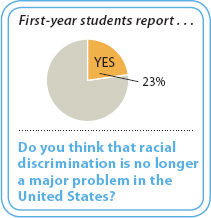Ethnicity, Culture, Race, and Religion
Often the words ethnicity and culture are used interchangeably, although their definitions are quite distinct. Throughout this chapter we will use these two terms together and in isolation. Before we start using them, it’s a good idea to learn their definitions so that you’re clear on what they actually mean.

Ethnicity refers to the identity that is assigned to a specific group of people who are historically connected by a common national origin or language. For example, let’s look at one of the largest ethnic groups, Latinos. Latin America encompasses more than thirty countries within North America, Central America, and South America, all of which share the Spanish language. A notable exception is Brazil, but even though the national language is Portuguese, Brazilians are considered Latinos (both Spanish and Portuguese are languages that evolved from Latin). The countries also share many traditions and beliefs, with some variations, but we shouldn’t generalize. Not every Latino who speaks Spanish is of Mexican descent, and not every Latino speaks Spanish. Acknowledging that differences exist within ethnic groups is a big step in becoming ethnically aware.
ethnicity An affiliation assigned to a specific group of people historically connected by a common national heritage or language.
culture The aspects of a group of people that are passed on or learned. Traditions, food, language, clothing styles, artistic expression, and beliefs are all part of culture.
Culture is defined as those aspects of a group of people that are passed on or learned. Traditions, food, language, clothing styles, artistic expression, and beliefs are all part of culture. Certainly, ethnic groups are also cultural groups; They share a language, foods, traditions, art, and clothing, which are passed from one generation to the next. Numerous other, nonethnic cultural groups can fit this concept of culture, too. Think of the hip-hop community, in which a common style of dress, specific terminology, and distinct forms of musical and artistic expression also constitute a culture but not an ethnicity.
race A term that refers to biological characteristics shared by groups of people, including skin tone, hair texture and color, and facial features.
Although we don’t use the term race often in this chapter, it’s important to understand this word as it is commonly used in everyday language. Race refers to biological characteristics that are shared by groups of people, including skin tone, hair texture and color, and facial features. Making generalizations about someone’s racial group affiliation is risky. Even people who share some biological features—such as similar eye shape or dark skin—might be ethnically very distinct. For instance, people of Asian descent are not necessarily ethnically and culturally alike because Asia is a vast region encompassing such disparate places as Mongolia, India, and Japan. Likewise, people of African descent come from very different backgrounds; the African continent is home to more than fifty countries and hundreds of different languages, and Africans are genetically very diverse. More and more individuals today, including President Barack Obama, describe themselves as multiracial. You might meet fellow students whose families include parents, grandparents, and great-grandparents of several different racial groups.
We come into the world with our own unique characteristics—aspects of our physical appearance and personalities that make us who we are—but people around the world have one attribute in common: We want to be respected even if we are different from others in some ways. Whatever the color of your skin or hair, whatever your life experiences or cultural background, you will want others to treat you fairly and acknowledge and value your contribution to your communities and the world. Of course, others will also want the same from you.
Diversity of religion has been central to the American experience since the country’s colonial origins. In fact, many settlers of the original thirteen colonies came to North America to escape religious persecution. Religious diversity might or might not have been obvious in your hometown or neighborhood, but unless you are attending an institution that enrolls only students of one religious sect, you will find religious diversity to be part of your college experience. Religious denominations might sponsor campus centers or organizations, and students’ religious affiliations might determine their dress, attitudes, or avoidance of certain behaviors. While you are in college, your openness to religious diversity will add to your understanding of the many ways in which people are different from one another.
Is This You?
Are you a student who has recently come to the United States from another country? Perhaps you have immigrated to the United States with family members, or perhaps you immigrated on your own. Whatever your particular situation, learning the unique language, culture, and expectations of a United States college or university can be a challenge, especially if your primary language is not English. You might find that instructors’ expectations seem different from what you experienced in your home country. In the United States, instructors want students to speak up in class and work in groups. You will also find that American students will sometimes challenge their instructors in ways that might seem disrespectful to you. Even if you don’t feel comfortable with your language skills, don’t give up. Your college or university probably offers English as a Second Language courses or programs to help you with your English skills. Also, visit the international student office or center to investigate ways to increase your understanding of life in the United States, both on and off campus.